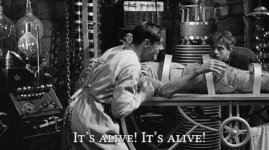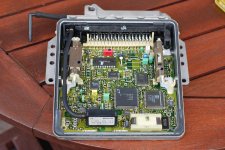Gotta watch those polymer caps, esr is so much lower than conventional parts. That may be inviting something you don’t want. If they work, then they will last forever though!
I have a bag that I will likely never use, there isn’t a regulator that can handle them and still function correctly, and they aren’t even large enough to be filter/smoother parts...
I have a bag that I will likely never use, there isn’t a regulator that can handle them and still function correctly, and they aren’t even large enough to be filter/smoother parts...
hmm indeed. Maybe I should change my order for the 10v 220uF polymer cap, that one was going into my ECU.
Thought this fun little fact was interesting:
So much for my thinking that I was being really really bad thinking about blocking off my EGR. and that I was contributing "really bad nasty pollution" that isn't found in nature by doing so. Turns out I was just stopping something that mother nature does herself.
https://en.wikipedia.org/wiki/NOx#Natural_sourcesNitric oxide is produced during thunderstorms due to the extreme heat of lightning,[8] and is caused by the splitting of nitrogen molecules. This can result in the production of acid rain, if nitric oxide forms compounds with the water molecules in precipitation. Scientists Ott et al.[9] estimated that each flash of lightning on average in the several mid-latitude and subtropical thunderstorms studied turned 7 kg (15 lb) of nitrogen into chemically reactive NOx. With 1.4 billion lightning flashes per year, multiplied by 7 kilograms per lightning strike, they estimated the total amount of NOx produced by lightning per year is 8.6 million tonnes. However, NOx emissions resulting from fossil fuel combustion are estimated at 28.5 million tonnes.[10]
So much for my thinking that I was being really really bad thinking about blocking off my EGR. and that I was contributing "really bad nasty pollution" that isn't found in nature by doing so. Turns out I was just stopping something that mother nature does herself.
Last edited:
And I'm not doing this because I'm a wild conspiracy theorist when it comes to emissions controls. I'm on the lookout for low rpm power gains because that is where I spend most if not all of my time when I'm in overdrive gear. If I can get my car up the hills that are around here while its stuck in overdrive gear without it knocking back into 2nd then I can save considerable amounts in fuel.
hills that are around here while its stuck in overdrive gear without it knocking back into 2nd then I can save considerable amounts in fuel.
Not necessarily. Your car may require more throttle to create the torque needed to move the car up grade in overdrive than it does in direct drive.
There may be slightly less friction loss in direct, but the power required in either gear is nearly the same. Power is torque * RPM / a constant. Depending on the engine design it may be more efficient making less torque at a higher RPM than more torque at a lower RPM. Most older engines have maximum efficiency near their peak torque RPM.
My Honda Element will drop from 5th, to 4th or 3rd when encountering hills. It is an early vintage (2008) drive by wire system. It was not programmed for trailer towing, since towing anything over 400 kilos is not recommended. When I tow a heavy trailer (over 1000 Kg), I force 3rd gear when driving in the mountains primarily to avoid the transmission wear from the constant shifting between the top 3 gears. I was surprised to find a significant MPG increase by doing this. Note, the Element gets 25 to 27 MPG highway MPG depending on speed. This drops to 11 to 13 MPG with the trailer in automatic mode, and 13 to 15 MPG locked in 3rd. There is a 2 mile upgrade in Tennessee where the brain chooses 3rd anyway with the trailer and the tach will sit on 5200 RPM with the pedal on the floor for just over two minutes. This will melt the exhaust valves on wimpy engines.
It’s better for a motor to be spinning at higher rpm (not red line but spinning) then loading it heavily at low rpm. Your bearings are lubricared only once per revolution, load the motor at low revs and your giving a lot of time for the oil to be squeezed out. Plus building a lot of cylinder pressure at low rpm is asking for predetonation which in my opinion is asking to melt something down.
The element doesn’t melt down because the ecu adds enough fuel at high load to cool the inside of the motor. Back off and it runs 14.7 air/fuel ratio under load probably somewoarourd 11 or 12/1. That in addition to the knock sensor that takes timing away if it pings keeps it safe
The element doesn’t melt down
I remember pulling a trailer through lesser mountains with a 1968 Plymouth station wagon powered by a carburated 318 CID V8 and losing power slowly throughout the trip with the greatest loss coming after an uphill climb on a hot summer day. Autopsy after the trip revealed several cylinders with low compression caused by toasted exhaust valves. Metallurgy has improved a lot since 1968.
Your bearings are lubricared only once per revolution
Most main bearings are grooved so they have a "full flow" oil path. This puts oil into the crankshaft continuously. Most rod bearings are not grooved, but oil is continuously fed to the bearing. The oil hole only lubricates one area at a time. The high load area is at the top of the rod which does only receive oil once per revolution, it sees high load twice.
The nominal oil pressure going into the crankshaft may be around 40 PSI. The oil pressure at the rod journal is multiplied by the centrifugal force on the spinning crankshaft, which is a function of the RPM and the stroke length. Your rod bearings like RPM, not lugging. It is rare to find bad rod bearings in today's engines though.
The best volumetric efficiency is typically around 1,000 rpm below peak torque.
Have you checked the valve clearances lately?
My experience with higher mileage Toyota engines is that the clearances tend to diminish slightly. That makes it easier to correct, by removing a thousandth of an inch or two from the back side of the follower/shim. I will use Emory cloth on a flat surface, holding the part by making a shallow pocket into a piece of wood.
Not that it will likely be a contributor to the poor running, but worth checking if you have the opportunity.
We were towing a full 6’ X 8’ enclosed trailer behind a V6 Camry once in the mountains in Northern California, and my dad was leaving it in drive, wouldn’t listen when I had said that things were going to heat up as it was constantly shifting, and that it would be better to select a lower gear.
At the next fuel stop, the lockup torque converter had stuck engaged, and it chugged to a halt in front of the gas pumps, stalling the engine.
I drove after that, in a lower gear, until we got out of the mountain areas. Not too many times where I went on to correct my pops, but I sure didn’t want to be stranded on some hiway with a full trailer, while being two states away from home.
He maintained that he was saving gas by leaving it in overdrive...
Have you checked the valve clearances lately?
My experience with higher mileage Toyota engines is that the clearances tend to diminish slightly. That makes it easier to correct, by removing a thousandth of an inch or two from the back side of the follower/shim. I will use Emory cloth on a flat surface, holding the part by making a shallow pocket into a piece of wood.
Not that it will likely be a contributor to the poor running, but worth checking if you have the opportunity.
We were towing a full 6’ X 8’ enclosed trailer behind a V6 Camry once in the mountains in Northern California, and my dad was leaving it in drive, wouldn’t listen when I had said that things were going to heat up as it was constantly shifting, and that it would be better to select a lower gear.
At the next fuel stop, the lockup torque converter had stuck engaged, and it chugged to a halt in front of the gas pumps, stalling the engine.
I drove after that, in a lower gear, until we got out of the mountain areas. Not too many times where I went on to correct my pops, but I sure didn’t want to be stranded on some hiway with a full trailer, while being two states away from home.
He maintained that he was saving gas by leaving it in overdrive...
6’ X 8’ enclosed trailer behind a V6 Camry
All Elements have a 2.4L 4 cylinder. I changed to a smaller diameter but wider tire size to gain the equivalent of 8% more final drive ratio. It helps pull the trailer.
Have you checked the valve clearances lately?
No, I have done virtually zero maintenance on the power train other than changing the oil whenever the dashboard reminder tells me to, always with Mobil 1. The reminder has some intelligence behind it since it will go about 8000 miles of highway driving without the trailer, and about 1500 with it. It is a 5 X 8 foot box, about as aerodynamic as a parachute tied to the trailer hitch. I haven't towed anything in the last 20K miles though other than a short trip to Home Depot or Lowes.
Fair enough tubelab. I usually turn overdrive off when I'm warming a car up and when going up and down hills, was hoping that I could leave it on for a benefit but as you say its best to simply leave the gear ratio at 1:1 to prevent wear and tear on the gearbox and provide best power transfer efficiency to the wheels from the engine.
Deleting the EGR might be a good idea anyway because I could always do with some lower end torque getting quicker off at the lights and into a lower gear sooner. Plenty of street lights around here.
The entire idea behind this build is lightweightness, fuel economy, power, low end torque, reliability and a strong focus on carrying heavy loads with a light but strong frame and chassis. I would've bought a Ford Ranger but I know fords, they rust pretty quickly because Ford doesn't even bother to weld their seams properly. I would've bought a Hilux too then but I can't fit in one. That just leaves the Toyota Landcruiser but I can't afford that. So I bought a V6 camry, not one of the 1MZ-FE or 5S-FE sludgemasters rather the older more well built and designed 3VZ-FEs. I don't know why they kept the 3VZ-FE around in Australia for so long (up until 1997) but I'm glad that they did.
Much like how an aeroplane carries a large heavy load in its belly but it itself is made from aluminum. One thing I won't skip on however is steel wheels and repair of the car. Which means getting the transmission inspected and possibly having a low mileage spare to go into it, and also rebuilding the engine if necessary, even if not necessary at some point in the future. Also inspecting the car body on a regular basis for rust spots and fixing them immediatley.
The mentioning of steel wheels is that if I hit a nasty big rock my soft city alloy wheels will be toast. So steel wheels it is. 17 inchers if I can fit them under there.
The car itself has already been fish oiled inside the boot. One thing that I will need to look at is the rear boot rubber weather stripping, I've already looked at the area and there isn't rust there yet, but there will be at some point I can guarantee it, underneath that it is catching dirt and that dirt is rubbing up against the paintwork. I think it would be best that I simply sand back that entire area with some 1000 grit and respray that entire seam around the boot opening and then add some silicone grease or silicone RTV to the entire area to ensure that no rust is ever going to begin forming there by blocking the water and dirt from getting in there in the first place. While also replacing the old rubber seal if I can get one from rarespares that is.
The other thing to look at is window door rubber seals, one is lifting on the rear drivers side door and letting rain inside of the door. all of those will need to be replaced.
I still haven't looked in the air vent underneath the front windscreen but I see no reason to, I highly doubt rust is present in there but I will go in there anyway and maybe spray the entire area with spray putty. That will prevent any rainwater from ever coming into contact with the metalwork. I will have to remember to do both the roof and the bottom, the roof can rust quite easily due to the humidity.
Once all of that is done I can then try and hunt down a bullbar. Because: YouTube
Deleting the EGR might be a good idea anyway because I could always do with some lower end torque getting quicker off at the lights and into a lower gear sooner. Plenty of street lights around here.
My trailer. Once bought, probably late next year, will be 100% aerodynamic and smooth, I will probably make a lid for the trailer out of fiberglass to save on weight.6’ X 8’ enclosed trailer behind a V6 Camry
The entire idea behind this build is lightweightness, fuel economy, power, low end torque, reliability and a strong focus on carrying heavy loads with a light but strong frame and chassis. I would've bought a Ford Ranger but I know fords, they rust pretty quickly because Ford doesn't even bother to weld their seams properly. I would've bought a Hilux too then but I can't fit in one. That just leaves the Toyota Landcruiser but I can't afford that. So I bought a V6 camry, not one of the 1MZ-FE or 5S-FE sludgemasters rather the older more well built and designed 3VZ-FEs. I don't know why they kept the 3VZ-FE around in Australia for so long (up until 1997) but I'm glad that they did.
Much like how an aeroplane carries a large heavy load in its belly but it itself is made from aluminum. One thing I won't skip on however is steel wheels and repair of the car. Which means getting the transmission inspected and possibly having a low mileage spare to go into it, and also rebuilding the engine if necessary, even if not necessary at some point in the future. Also inspecting the car body on a regular basis for rust spots and fixing them immediatley.
The mentioning of steel wheels is that if I hit a nasty big rock my soft city alloy wheels will be toast. So steel wheels it is. 17 inchers if I can fit them under there.
The car itself has already been fish oiled inside the boot. One thing that I will need to look at is the rear boot rubber weather stripping, I've already looked at the area and there isn't rust there yet, but there will be at some point I can guarantee it, underneath that it is catching dirt and that dirt is rubbing up against the paintwork. I think it would be best that I simply sand back that entire area with some 1000 grit and respray that entire seam around the boot opening and then add some silicone grease or silicone RTV to the entire area to ensure that no rust is ever going to begin forming there by blocking the water and dirt from getting in there in the first place. While also replacing the old rubber seal if I can get one from rarespares that is.
The other thing to look at is window door rubber seals, one is lifting on the rear drivers side door and letting rain inside of the door. all of those will need to be replaced.
I still haven't looked in the air vent underneath the front windscreen but I see no reason to, I highly doubt rust is present in there but I will go in there anyway and maybe spray the entire area with spray putty. That will prevent any rainwater from ever coming into contact with the metalwork. I will have to remember to do both the roof and the bottom, the roof can rust quite easily due to the humidity.
Once all of that is done I can then try and hunt down a bullbar. Because: YouTube
Last edited:
Its alive!
Finally after 6 months of working hard at it its running like a Casio again. Just like it did when I first bought the car. Acceleration is the smoothest I've ever experienced, as nearly as smooth and quiet as an electric car. Exactly what the 3VZ-FE is supposed to sound like, 3VZ-FE is supposed to be the smoothest running engine that Toyota ever developed. But better, this time with Denso Twin Tip spark plugs.
I drove it around for 30 minutes. Another test tomorrow will tell me weather or not if I have completely fixed itself, but signs are REALLY good!
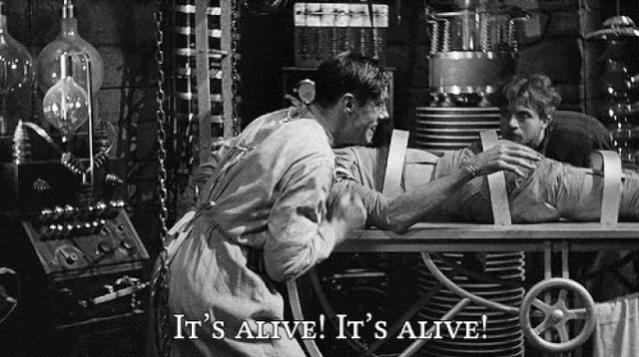
Finally after 6 months of working hard at it its running like a Casio again. Just like it did when I first bought the car. Acceleration is the smoothest I've ever experienced, as nearly as smooth and quiet as an electric car. Exactly what the 3VZ-FE is supposed to sound like, 3VZ-FE is supposed to be the smoothest running engine that Toyota ever developed. But better, this time with Denso Twin Tip spark plugs.
I drove it around for 30 minutes. Another test tomorrow will tell me weather or not if I have completely fixed itself, but signs are REALLY good!
Attachments
Last edited:
I noticed when I pulled the ECU from the car that the ECU was covered in this corrosion on just one end of it. This is why you don't leave your wet tools in the boot of your car folks. Anyway this is also why I have a container of moisture absorber in my car.
This corrosion hasn't gotten inside of the ECU despite it being very easy for it to do, I got lucky, the entire PCBs are covered in a protective epoxy coating. So moisture won't affect it. But a leaking capacitor spewing electrolyte on the PCB sure will!
The PCB was kind to me and didn't really act up or misbehave when trying to pull the capacitors out. I would recommend however some small wire cutters to get in underneath the caps and clip them out first. But I didn't have to do that.
The recapping process:
I first replaced three decoupling capacitors. I then started to work on the damaged area of the pcb surrounding the 220uF capacitor.
I got some isopropyl alcohol and some q tips and cleaned the black area around the 220uF capacitor.
I checked the traces and scraped back the protective layer off of the traces underneath, I then put my multimeter on the traces and traced them back to the switching transistors below. Each transistor corresponded to a certain trace, I simply scraped back some of the protective layer up above on the pcb and made sure that the traces were still connected.
Making sure that the traces were still working, I simply replaced the capacitor (it smelt like urine when I was removing the 220uF capacitor) and got some superglue and covered the traces again with a layer of superglue.
I then reassembled the entire computer and sanded back the corrosion on the outside of the ECU case with some 100 grit wet and dry sandpaper.
My suspicion is that the leaking electrolyte was conducting electricity to the switching transistor and making the injector turn on and stay on, or that it was earthing it to the earthed side of the capacitor.
This corrosion hasn't gotten inside of the ECU despite it being very easy for it to do, I got lucky, the entire PCBs are covered in a protective epoxy coating. So moisture won't affect it. But a leaking capacitor spewing electrolyte on the PCB sure will!
The PCB was kind to me and didn't really act up or misbehave when trying to pull the capacitors out. I would recommend however some small wire cutters to get in underneath the caps and clip them out first. But I didn't have to do that.
The recapping process:
I first replaced three decoupling capacitors. I then started to work on the damaged area of the pcb surrounding the 220uF capacitor.
I got some isopropyl alcohol and some q tips and cleaned the black area around the 220uF capacitor.
I checked the traces and scraped back the protective layer off of the traces underneath, I then put my multimeter on the traces and traced them back to the switching transistors below. Each transistor corresponded to a certain trace, I simply scraped back some of the protective layer up above on the pcb and made sure that the traces were still connected.
Making sure that the traces were still working, I simply replaced the capacitor (it smelt like urine when I was removing the 220uF capacitor) and got some superglue and covered the traces again with a layer of superglue.
I then reassembled the entire computer and sanded back the corrosion on the outside of the ECU case with some 100 grit wet and dry sandpaper.
My suspicion is that the leaking electrolyte was conducting electricity to the switching transistor and making the injector turn on and stay on, or that it was earthing it to the earthed side of the capacitor.
Attachments
-
 209-diyaudio.jpg124.4 KB · Views: 69
209-diyaudio.jpg124.4 KB · Views: 69 -
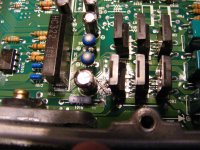 208-diyaudio.jpg137.9 KB · Views: 77
208-diyaudio.jpg137.9 KB · Views: 77 -
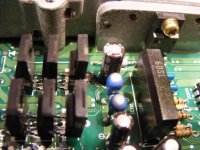 207-diyaudio.jpg108.3 KB · Views: 61
207-diyaudio.jpg108.3 KB · Views: 61 -
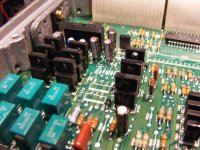 206-diyaudio.jpg127.2 KB · Views: 83
206-diyaudio.jpg127.2 KB · Views: 83 -
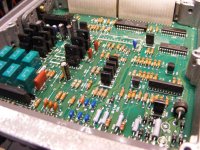 205-diyaudio.jpg148 KB · Views: 73
205-diyaudio.jpg148 KB · Views: 73 -
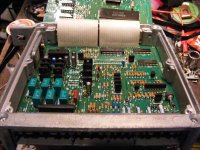 204-diyaudio.jpg131.2 KB · Views: 67
204-diyaudio.jpg131.2 KB · Views: 67 -
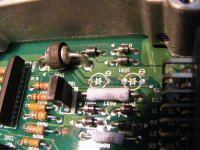 203-diyaudio.jpg113.8 KB · Views: 82
203-diyaudio.jpg113.8 KB · Views: 82 -
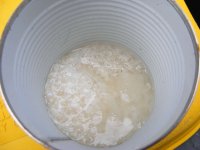 202-b--diyaudio.jpg54.2 KB · Views: 115
202-b--diyaudio.jpg54.2 KB · Views: 115 -
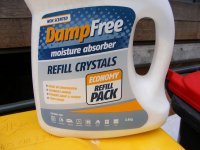 202-a--diyaudio.jpg82.1 KB · Views: 118
202-a--diyaudio.jpg82.1 KB · Views: 118 -
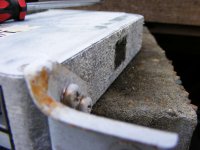 202-diyaudio.jpg75.9 KB · Views: 114
202-diyaudio.jpg75.9 KB · Views: 114
Last edited:
2nd set of pics:
Attachments
-
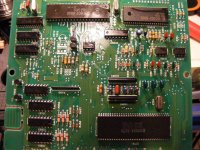 219-diyaudio.jpg165 KB · Views: 79
219-diyaudio.jpg165 KB · Views: 79 -
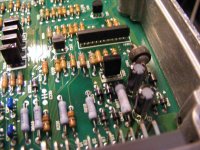 218-diyaudio.jpg123.8 KB · Views: 78
218-diyaudio.jpg123.8 KB · Views: 78 -
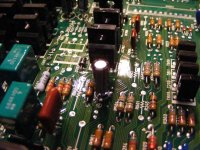 217-diyaudio.jpg128.9 KB · Views: 61
217-diyaudio.jpg128.9 KB · Views: 61 -
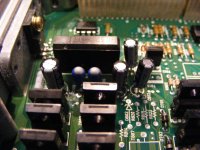 216-diyaudio.jpg102.6 KB · Views: 75
216-diyaudio.jpg102.6 KB · Views: 75 -
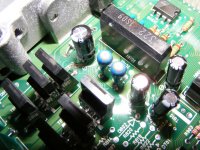 214-diyaudio.jpg151.9 KB · Views: 67
214-diyaudio.jpg151.9 KB · Views: 67 -
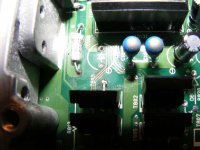 213-diyaudio.jpg90 KB · Views: 68
213-diyaudio.jpg90 KB · Views: 68 -
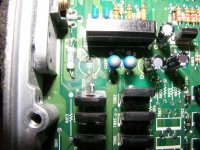 212-diyaudio.jpg134.6 KB · Views: 68
212-diyaudio.jpg134.6 KB · Views: 68 -
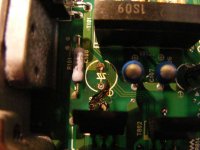 211-diyaudio.jpg73.1 KB · Views: 80
211-diyaudio.jpg73.1 KB · Views: 80 -
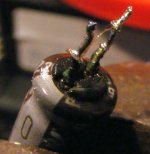 210-diyaudio.jpg99.5 KB · Views: 79
210-diyaudio.jpg99.5 KB · Views: 79 -
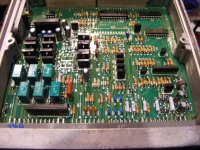 215-diyaudio.jpg294.7 KB · Views: 79
215-diyaudio.jpg294.7 KB · Views: 79
not bad. Yours has a rubber seal too. Mine doesn't. But it will as soon as I know that its working I'll put RTV around the edges and then seal up the screw holes with some aluminium tape.
I just came back from taking it for another drive for 30 mins and its still not acting up. But as I know from prior experience its usually the day after that I find out if its really fixed or not.
In other news I kinda got an Alfa Romeo hatchback off at the lights tonight, I had him until his turbo kicked in at around 50km/h. I was just going up to the speed limit too, speed limit being 50km/h, he wasn't.
That was with half throttle and an ecu that is still learning and with built up traffic. 6pm and all that. Should I really be picking on little Alfa's?
I just came back from taking it for another drive for 30 mins and its still not acting up. But as I know from prior experience its usually the day after that I find out if its really fixed or not.
In other news I kinda got an Alfa Romeo hatchback off at the lights tonight, I had him until his turbo kicked in at around 50km/h. I was just going up to the speed limit too, speed limit being 50km/h, he wasn't.
That was with half throttle and an ecu that is still learning and with built up traffic. 6pm and all that. Should I really be picking on little Alfa's?
Attachments
Last edited:
hehe, I have to admit that my biggest grins used to be when I managed to get the jump on alpha's at the lights in my morris1100 😀 It worked best when there was a tight corner immediately off the lights. The morrie could just go full throttle without any issues, which gave me an edge.
I remember I got one guy two days running at the same two sets of lights. onramp onto the M4 going west and offramp turning right onto James Ruse drive. The second day he was really pissed!! 😀
Tony.
I remember I got one guy two days running at the same two sets of lights. onramp onto the M4 going west and offramp turning right onto James Ruse drive. The second day he was really pissed!! 😀
Tony.
But it will as soon as I know that its working I'll put RTV around the edges
Be cautious of using RTV near copper in a moist environment. The fumes outgassed from RTV caused the copper PCB's in some microwave receivers I built back in the 90's to corrode to death. I have not used it since, so I don't know if the current stuff is the same way.
Just got back from driving my car for 80 minutes. No issues.
Aside from the fact that the suspension on the drivers side is lower a little bit than the left/passengers side and the entire car is tilting to the side. possibly because my tools are still in the boot.
It would be a good idea for me to focus now on wheel bearings, bushings, inner and outer tie rod ends, tie rod end boots. Wheel alignment. Disc Brakes, then do the suspension last, etc.
But I would like to get a battery box I think and have some fun with the stereo system.
But first I had better revisit the climate control system, it was flickering again. I think I might just remove all of the globes out of it and solder some same sized incandescent globes directly to the pcb. ensuring that I don't use higher wattage globes that could melt the plastic.
Its probably also a good idea that I reattach all of the aerodynamic plastic bits and pieces to the car again, it was quite noisy when I was out on the road tonight without the pieces. Think I'll go down to bunnings and buy some thickish black plastic material and make my own air dam, the factory one is pretty rooted and ripped in some places.
Aside from the fact that the suspension on the drivers side is lower a little bit than the left/passengers side and the entire car is tilting to the side. possibly because my tools are still in the boot.
It would be a good idea for me to focus now on wheel bearings, bushings, inner and outer tie rod ends, tie rod end boots. Wheel alignment. Disc Brakes, then do the suspension last, etc.
But I would like to get a battery box I think and have some fun with the stereo system.
But first I had better revisit the climate control system, it was flickering again. I think I might just remove all of the globes out of it and solder some same sized incandescent globes directly to the pcb. ensuring that I don't use higher wattage globes that could melt the plastic.
Its probably also a good idea that I reattach all of the aerodynamic plastic bits and pieces to the car again, it was quite noisy when I was out on the road tonight without the pieces. Think I'll go down to bunnings and buy some thickish black plastic material and make my own air dam, the factory one is pretty rooted and ripped in some places.
Last edited:
Going to go start it up this morning.
Last night I bought a battery box and some mounting hardware and two 150a waterproof circuit breakers:
150A Manual Reset Circuit Breaker Motor Accessory Car Boat Waterproof | eBay
PROJECTA BB285 BATTERY BOX CARRY CASE 12V 80AH CAR AGM DEEP CYCLE DUAL SYSTEM | eBay
PROJECTA BHD18M UNIVERSAL BATTERY HOLD DOWN TRAY CLAMP 160mm to 175mm CLAMPS KIT | eBay
Heavy Duty 35mm2 Jumper Leads Cable Long Jump Car Booster Copper Cables 1m-100m | eBay
10x Mini Bulbs Lamps For GM Speedmeter Cluster Backlight Lighting 12v-14v 1.4W | eBay
https://www.ebay.com.au/itm/4Pcs-T3...tch-Cluster-Warning-Green-Colour/192602919348
Got 2 meters of 35mmSQ, just enough to do the run to the amplifiers from the auxiliary battery in the boot.
Only thing left to buy is a dual battery solenoid. I didn't buy a large battery box because I'm concerned about the weight of a 100-120AH battery. I shouldn't need that many amp hours anyway. The small one is limited at a size of 80 amp hours. I might put a 40 or 50AH battery in there to save even more on weight.
The only reason why I want a dual battery is because I need the power to run my amps, and for occasional low power ham radio operation. say 10 watts, maybe a shot of 50 watts now and again. and those are while the alternator are running. I would be running 1-10w watt RF most of the time the alternator is turned off so there is no need for a huge battery in the boot, a large heavy battery is just going to end up messing with my driving feel.
Last night I bought a battery box and some mounting hardware and two 150a waterproof circuit breakers:
150A Manual Reset Circuit Breaker Motor Accessory Car Boat Waterproof | eBay
PROJECTA BB285 BATTERY BOX CARRY CASE 12V 80AH CAR AGM DEEP CYCLE DUAL SYSTEM | eBay
PROJECTA BHD18M UNIVERSAL BATTERY HOLD DOWN TRAY CLAMP 160mm to 175mm CLAMPS KIT | eBay
Heavy Duty 35mm2 Jumper Leads Cable Long Jump Car Booster Copper Cables 1m-100m | eBay
10x Mini Bulbs Lamps For GM Speedmeter Cluster Backlight Lighting 12v-14v 1.4W | eBay
https://www.ebay.com.au/itm/4Pcs-T3...tch-Cluster-Warning-Green-Colour/192602919348
Got 2 meters of 35mmSQ, just enough to do the run to the amplifiers from the auxiliary battery in the boot.
Only thing left to buy is a dual battery solenoid. I didn't buy a large battery box because I'm concerned about the weight of a 100-120AH battery. I shouldn't need that many amp hours anyway. The small one is limited at a size of 80 amp hours. I might put a 40 or 50AH battery in there to save even more on weight.
The only reason why I want a dual battery is because I need the power to run my amps, and for occasional low power ham radio operation. say 10 watts, maybe a shot of 50 watts now and again. and those are while the alternator are running. I would be running 1-10w watt RF most of the time the alternator is turned off so there is no need for a huge battery in the boot, a large heavy battery is just going to end up messing with my driving feel.
Last edited:
- Home
- Member Areas
- The Lounge
- The car thread
